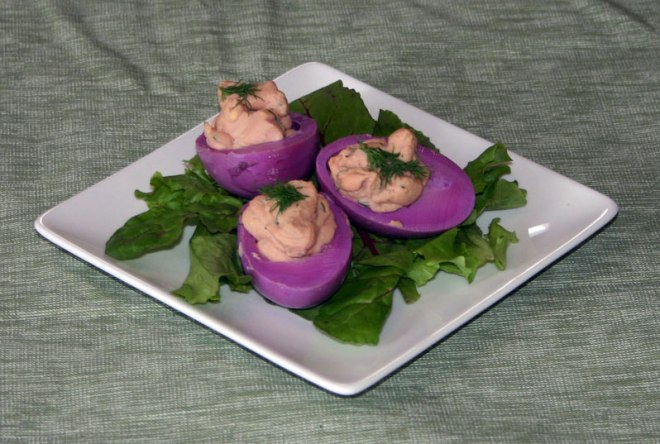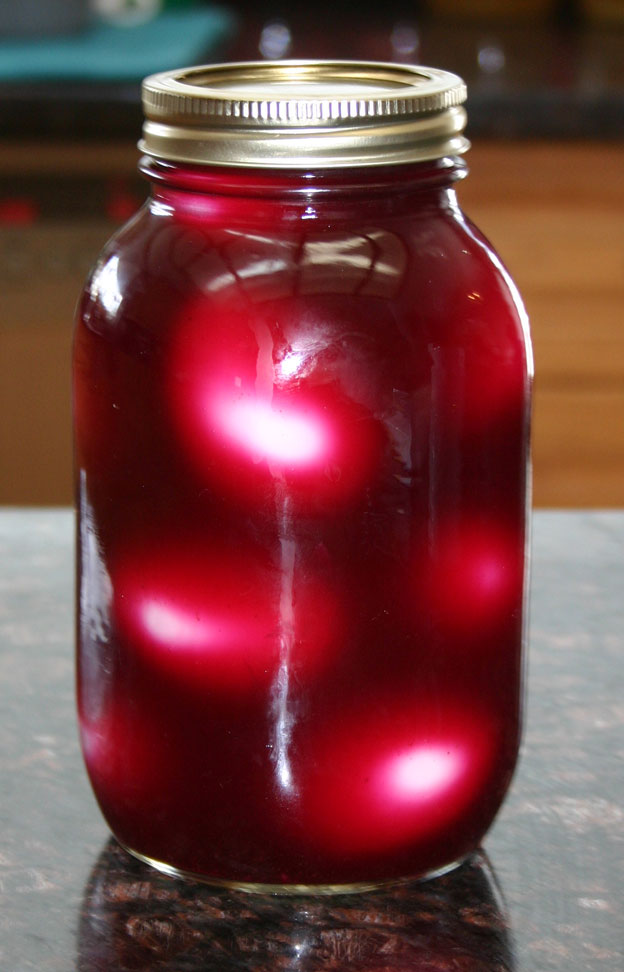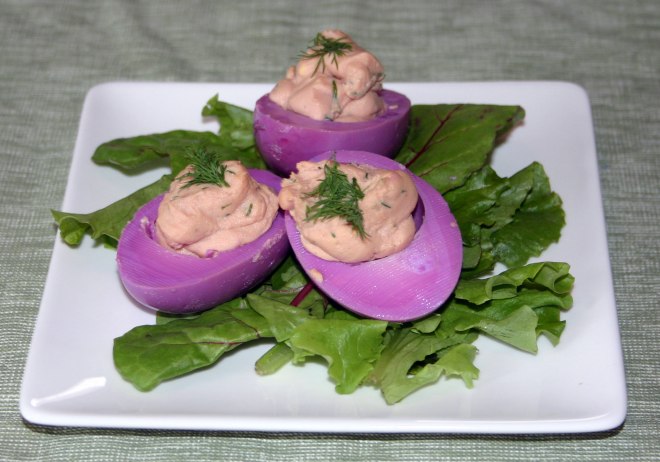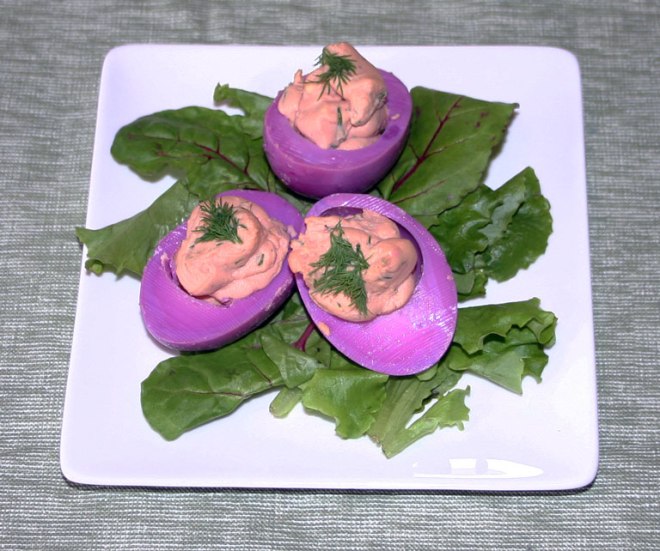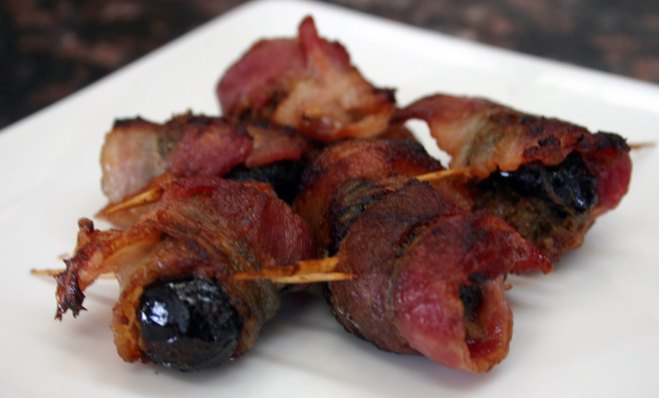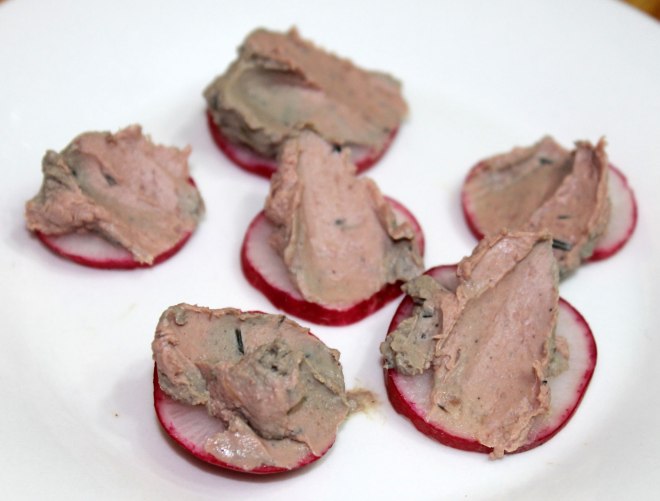This is the second batch of deviled eggs that I made for the Ostara Potluck I attended.

The first batch was the Pink Deviled Eggs I wrote about a few days ago.
Unlike the pink eggs, which used leftover beet brine, I made a fermented turmeric brine especially for these eggs. They will need to be started at least 2 weeks in advance of when you want to serve them in order for you to have time to ferment the turmeric brine.
But the results are worth it!
Turmeric adds the yellow colour to the outside of the eggs, and is also a powerful antioxidant and anti-inflamatory.
The avocado not only provides the green creamyness to the yolk filling, it also provides some heart-healthy monounsaturated fats, a ton of nutrients and yet more anti-inflammatory properties.
These are a stunning contribution to a potluck, but also make great snacks and would look wonderful on an Easter buffet table. They would also be good for breakfast or in packed lunches.
You could also just eat the turmeric pickled eggs whole without going to the trouble of cutting and filling them with the avocado mixture.
Whole eggs/egg whites are an AIP stage 2 reintroduction, so if you are following the AIP plan, you will need to wait until you have successfully reintroduced egg yolks and egg whites before eating these. When reintroducing foods on the AIP, I recommend this guide.
Turmeric Avocado Deviled Eggs
Makes 24 halved eggs
To make the turmeric brine:
- 2 TBSP pink Himalayan salt
- 1 small carrot – sliced – peel if not organic
- 2″fresh root ginger – sliced thinly
- 2″ fresh turmeric root – sliced thinly
- 4-5 slices fresh horseradish root
- 3 cloves garlic – peeled
- 3 bay leaves
- 2 sprigs fresh rosemary
- 2 sprigs fresh thyme
- 1 cabbage leaf (to weigh down the veggies to ensure they all stay underneath the brine)
To make the eggs
- 1 dozen eggs – preferably free-range/pastured/soy-free
To make the filling
- 1 large ripe avocado – peeled and diced
- sea salt to taste
- 1 tbsp fresh parsley – chopped
- 1 tbsp fresh basil – chopped
- 1 tbsp fresh chives – chopped
- 1 tbsp fresh thyme – chopped
- 1 clove garlic
- 2 tbsp lemon juice
- 2 tbsp extra virgin olive oil
The first thing that needs to be done is that the brine needs to be made and fermented. This needs to be started at least 2 weeks before you want to serve the eggs.
Take all the brine ingredients, except for the cabbage, and put them in a quart mason jar. Add filtered water to cover and mix well to dissolve the salt. Tuck the cabbage leaf on top of the veggies to hold them down under the brine. If necessary weigh this down with a small jar or shot-glass filled with brine.
Cover and leave to stand at room temperature for at least 7 days. It may get fizzy and bubbly as the naturally occurring cultures start to ferment the sugars in the veggies and herbs. This is normal. Open the lid every now and again to release the gas.
Once the brine is fermented to your liking, strain out all the solids, reserving the fermented brine.
Take the dozen eggs, and place them in a pan with cold water. Bring to the boil, reduce the heat and simmer for 10 minutes.
Drain and place in cold water.
Once the eggs have cooled enough to handle, peel off the shells and pack the eggs in a large mason jar.
Carefully pour over the brine to cover the eggs.
Place the eggs in the fridge and leave to “pickle” for 5-7 days.
To make the deviled eggs…
Drain the eggs from the brine.
Cut each egg in half lengthwise and carefully scoop out the yolk.
Mash the yolks with the avocado.
Place the herbs, garlic, lemon juice and the olive oil in a blender or food processor and puree to a paste.
Add the herb puree to the egg yolks and avocado and mix well.
Season to taste with sea salt.
Carefully spoon or pipe the green mixture back into the egg whites and arrange on a serving platter.
Shared At Full PlateThursday
Shared at Home & Garden Thursday
Shared at All Things Thursday
Shared at Pure Blog Love
Shared at Natural Family Friday
Shared at What to do Weekends
Shared at Simply Natural Saturday



